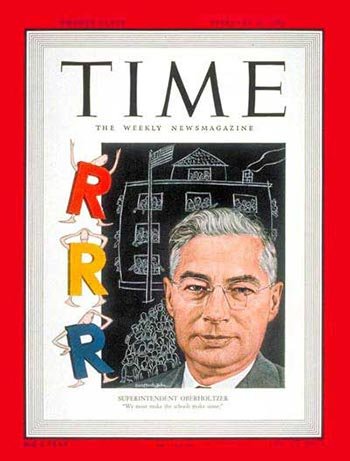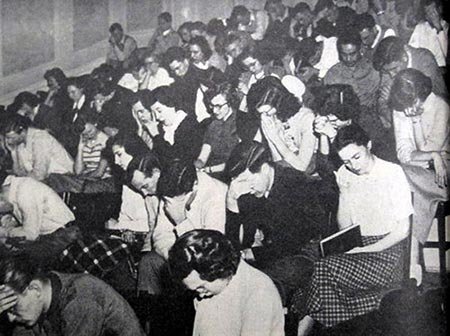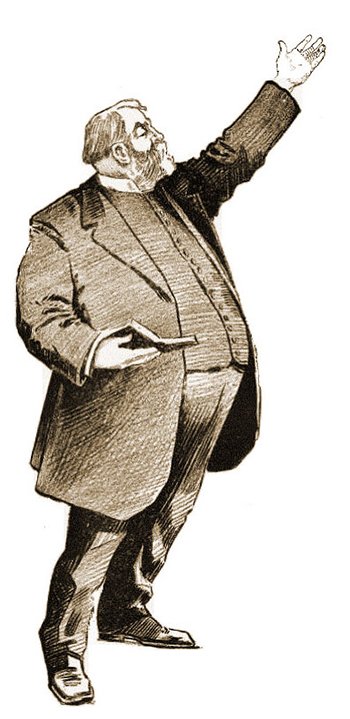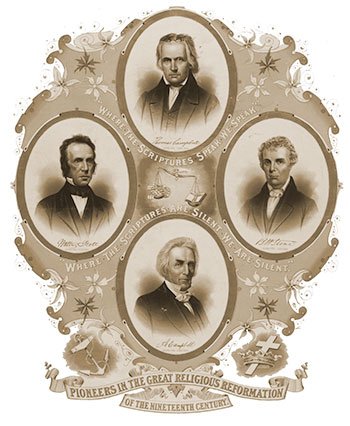Wheaton College Revival 1950
TIME MAGAZINE – FEBRUARY 20, 1950

Time Magazine 20th Feb. 1950
42 Hours of Repentance
Just after dinner one evening last week, balding, spectacled President Victor Raymond Edman of Illinois’ Wheaton College rose to begin a regular session of the Evangelistic Week that traditionally begins each term. Stepping up to the microphones in the brightly lit, rectangular auditorium of Pierce Memorial Chapel, he asked if any student would, ‘like to give a word of testimony or praise on the blessings of this week.’
President Edman was not surprised when several students trooped up to the rostrum.” (Students were asked to come and sit in the choir loft and move over and down one by one, after it became evident that too many were standing and waiting for too long, to testify or confess, but the reporters didn’t get there the first day. They came the second night).
Such impromptu declarations are not unusual at Wheaton, a little (1,300 students), non-denominational college which still bears the stamp of its strict fundamental heritage: no movies, smoking, card playing, dancing or drinking, a 10 p.m. curfew. But as the first students finished speaking, a surge of confessional fervor swept through the auditorium.
Christ or Baseball?
Singly and in little groups, sweatered and blue-jeaned undergraduates streamed onto the stage, filling up the choir chairs to await their turn. Hour after hour they kept coming. All night long, all the next day, all through the following night, and half the following day, students poured out confessions of past sins and rededicated themselves to God.
The auditorium filled up and overflowed into a smaller chapel downstairs. Classes had to be cancelled altogether. Some speakers came forward boldly and eagerly; other were so overcome with shyness they had to abandon the attempted come back later to try again. Some broke down completely.

Repentance amongst Wheaton students
Said one young man, ‘I have to confess that in the pass I felt undue pride in my membership in the Men’s Glee Club, and tended to look down on members of the Gospel Choir.’ Sniffled a determined brunette: ‘I want to say this publicly so that those who hear me will know I mean business. I know it’s mostly the fellows who say they have impure thoughts, but girls have them too.
And I want to apologize if I’ve ever tempted any of the fellows I’ve had contact with. I know I’ve tried, and I’m sorry.’ Said a young man with a Brooklyn accent, ‘I want to apologize for making the faculty the butt of my corny jokes…I want to get something else off my chest: giving thanks for food and then complaining about it.’
‘Twenty-four hours ago,’ declared a cheerful, ruddy baseball star, ‘This is the last thing I thought I’d be doing…Last night I looked in my yearbook, and after my name it said baseball is my main interest. I want to say: Christ is my main interest.’
Probing of the Heart.
One girl both committed her, ‘sin,’ and asked pardon for it while at the microphone. Many of her fellow students, she said, were ‘silly to give testimony,’ because she couldn’t believe they were sincere; then she asked forgiveness for doubting their sincerity. A spare young faculty member rose to confess: ‘I’ve led a double life.
I’ve lived a life of defeat…As you know, I was once a missionary in China. After the war started, I came back. I told people it was because of the war. But it wasn’t…It was because I didn’t want to go on being a missionary…I want you to pray for me so my life will really tell for God.’
There was little audible response to the confessions. Here & there, listeners sat with their heads in their hands. Patiently through all most all of it, waited the Rev. Edwin Johnson of Seattle’s First Mission Covenent Church, who, as leader of the Evangelistic Week, had been scheduled to address the group the night it all began. At last, President Edman gave him his chance at the microphone. ‘We’ve seen a probing of the heart today such as we’ve never seen before,’ said Johnson.
But when other confession-hungry heart probers began flocking to Wheaton–followed by the simply curious–President Edman discretely ended the public testimonies. After a few hours more of confessions, it was all over. 47 hours and 40 minutes after it started. ‘These kids are tired out,’ explained weary President Edman. ‘The testimonies have mostly to do with private matters. After all, the principle confessions are to Almighty God, not a public audience.’
For further research
A more complete account of the 1950 Wheaton College Revival
The 1950 Wheaton College Revival was a pivotal moment in the history of Wheaton College and American evangelicalism. This student-led revival, characterized by heartfelt confessions of sin, fervent rededications to faith, and a renewed emphasis on spiritual matters, had a profound and lasting impact on the lives of many participants and the broader evangelical movement. This article delves into the history of this remarkable event, exploring its antecedents, key moments, personal testimonies, and lasting legacy.
Antecedents of the Revival
The spiritual awakening that swept through Wheaton College in 1950 was not a sudden occurrence but rather the culmination of several contributing factors. In the fall of 1949, a senior retreat fostered a heightened awareness of spiritual realities among the student body. During this retreat, Phyllis Brattland, a beloved senior, requested prayer for her parents who were not Christians. Shortly after, tragedy struck the campus when Phyllis died in a car accident. This event deeply affected the students and prompted reflection on mortality and faith1.
Adding to this atmosphere of spiritual sensitivity was a remarkable prayer gathering held by mothers of students at Wheaton Academy, a private high school associated with the college. On January 30, 1950, these mothers came together to pray for their children and, in a profound act of humility, confessed their own sins to them. This display of vulnerability and repentance had a powerful impact on the students, and within days, every student at Wheaton Academy had committed to following Jesus1.
These events, coupled with the college’s tradition of holding evangelistic services at the beginning of each semester, created fertile ground for spiritual awakening1.
Religious Context in Post-War America
To fully understand the significance of the 1950 Wheaton College Revival, it’s crucial to consider the religious landscape of post-war America. Following World War II, there was a resurgence of religious interest in the United States. The “Protestant establishment,” encompassing denominations such as Baptists, Congregationalists, and Methodists, held a dominant position in American religious life2.
This post-war period saw a renewed desire for spiritual meaning and a yearning for moral certainty amidst the anxieties of the Cold War and the burgeoning social changes of the era. The Wheaton College Revival emerged within this context, reflecting a broader trend of spiritual seeking and revivalism in American society.
The Revival Unfolds
The revival began during a regularly scheduled evangelistic service on February 5, 19503. President Victor Raymond Edman opened the service, as was customary, by inviting students to share testimonies or words of praise1. Rev. Edwin Johnson of Seattle’s First Mission Covenant Church, the leader of the Evangelistic Week, was scheduled to address the students that evening3. However, what began as a typical service soon transformed into an extraordinary outpouring of confession and repentance.
Students, moved by a sudden and unexpected wave of conviction, began to stream towards the stage. Some approached with boldness and eagerness, while others hesitated, wrestling with shyness or stage fright before mustering the courage to share their burdens3. The confessions, raw and heartfelt, continued for hours, stretching through the night and into the next day. Classes were cancelled as the revival took hold of the campus, with the chapel overflowing into a smaller chapel downstairs3.
As the revival gained momentum, President Edman eventually made the decision to bring the public testimonies to a close. He felt that the confessions, while genuine, were becoming increasingly focused on private matters and risked being sensationalized. He emphasized that the most important confessions were to be made to God, not to a public audience3.
Personal Testimonies and Conversions
The personal testimonies shared during the revival were striking in their honesty and vulnerability. Students and faculty alike laid bare their struggles, anxieties, and shortcomings. One young man confessed, “I have to confess that in the past I felt undue pride in my membership in the Men’s Glee Club, and tended to look down on members of the Gospel Choir.” 3 A female student, with tears in her eyes, admitted, “I want to say this publicly so that those who hear me will know I mean business. I know it’s mostly the fellows who say they have impure thoughts, but girls have them too.
And I want to apologize if I’ve ever tempted any of the fellows I’ve had contact with. I know I’ve tried, and I’m sorry.’ 3
A baseball star, known for his cheerful demeanor and athletic prowess, stepped forward and declared, “Twenty-four hours ago, this is the last thing I thought I’d be doing…Last night I looked in my yearbook, and after my name it said baseball is my main interest. I want to say: Christ is my main interest.” 3
Even those who initially doubted the sincerity of others found themselves confessing their own struggles. One young woman admitted, “Many of my fellow students…were ‘silly to give testimony,’ because I couldn’t believe they were sincere; then she asked forgiveness for doubting their sincerity.” 3
Faculty members also participated in the outpouring of confession. One admitted to leading a double life, falling short of his missionary aspirations3. Another confessed to speaking unkindly about a colleague to students1.
These public displays of vulnerability had a profound impact. Numerous students were converted during the revival, including one of President Edman’s sons1. Even skeptics who came to observe the revival were moved by the sincerity of the participants, and some even joined in prayer1.
Prayers and Practices
While the revival was spontaneous in nature, certain prayers and practices contributed to its impact. The mothers’ prayer gathering at Wheaton Academy, with its emphasis on confession and repentance, set a powerful precedent for the revival that followed1. The college’s tradition of holding evangelistic services also played a role in creating an environment conducive to spiritual awakening3.
The act of public confession was central to the revival. By openly acknowledging their sins and shortcomings, students and faculty created a space for vulnerability and accountability. This, in turn, fostered a sense of community and encouraged others to seek forgiveness and rededication1.
Immediate and Lasting Results
The 1950 Wheaton College Revival had both immediate and long-term effects. In the immediate aftermath, there was a noticeable change in the atmosphere on campus. Jealousy and contention among faculty dissipated, replaced by a spirit of unity and reconciliation1. Many students experienced emotional healing and a renewed sense of purpose1.
The impact extended beyond the undergraduate campus. The neighboring Theological Seminary also experienced a surge in spiritual fervour, sending out hundreds of student teams to witness and share their experiences4.
The revival also had a lasting impact on the lives of many participants. A significant number of students, 39 percent of the class of 1950, devoted at least part of their lives to full-time Christian ministry1. The revival also inspired the establishment of ELWA Radio Station in Liberia, Africa, extending its reach to a global scale1.
Context and Relationship to Other Revivals
The 1950 Wheaton College Revival was one of several revivals that occurred on college campuses in the mid-20th century5. These revivals were part of a broader trend of religious awakening in the United States following World War II2. The Wheaton revival, in particular, gained national attention and inspired similar revivals at other colleges and universities6.
This revival demonstrated the interconnectedness of personal faith and communal experience, with individual confessions contributing to a collective sense of renewal3.
Wheaton College itself had a history of revivals, with notable events occurring in 1936 and 19437. The 1950 revival built upon this tradition and further solidified the college’s reputation as a center for evangelical faith and a catalyst for spiritual awakening.
Scholarly Perspectives
The 1950 Wheaton College Revival has been the subject of scholarly analysis and interpretation by historians and theologians. Timothy Beougher and Lyle W. Dorsett, in their book “Accounts of a Campus Revival: Wheaton College 1995,” provide a detailed account of the revival, exploring its historical context and theological significance8. They highlight the role of prayer, confession, and student leadership in shaping the revival’s trajectory.
Other scholars have examined the revival in relation to broader trends in American religious history. Nina K. Bissett, in her dissertation “Wesleyan Perfectionism in Revivals of the 19th and 20th Centuries at Wheaton College and Its Impact on Institutional Identity,” explores the influence of Wesleyan theology on the revival and its contribution to Wheaton College’s identity as an evangelical institution9.
These scholarly perspectives provide valuable insights into the revival’s historical context, theological underpinnings, and lasting impact on Wheaton College and the evangelical movement.
Timeline of Events
| Date | Event | Citation |
| Fall 1949 | Senior retreat fosters spiritual awareness; Phyllis Brattland requests prayer for her parents. | 1 |
| Shortly after Fall 1949 retreat | Phyllis Brattland dies in a car accident, prompting reflection on faith and mortality. | 1 |
| January 30, 1950 | Mothers at Wheaton Academy hold a prayer gathering and confess their sins to their children, sparking a spiritual awakening at the academy. | 1 |
| By Wednesday of the week of January 30, 1950 | Every student at Wheaton Academy commits to following Jesus. | 1 |
| February 5, 1950 | Weeklong evangelistic services begin at Wheaton College. | 3 |
| February 7, 1950 | Revival breaks out during an evangelistic service led by President Edman. | 3 |
| February 7-8, 1950 | Students and faculty share confessions and testimonies for 39 hours. | 3 |
| February 8, 1950 | Classes are canceled as the revival continues. | 3 |
| February 9, 1950 | President Edman brings the public testimonies to a close, emphasizing the importance of personal confession to God. | 3 |
| Following weeks | Student teams visit other colleges and churches, sharing their experiences and witnessing, further spreading the revival’s impact. | 4 |
Beneficial Takeaways
The 1950 Wheaton College Revival offers several valuable lessons for individuals and communities seeking spiritual renewal:
- The power of prayer: The revival was preceded and sustained by prayer, both individual and communal, highlighting the importance of seeking God’s guidance and intervention1.
- The importance of confession and repentance: Public confession played a key role in breaking down barriers, fostering a spirit of humility and accountability, and creating an environment for genuine repentance1.
- The potential for transformation: The revival demonstrated the transformative power of the Holy Spirit to change lives, heal emotional wounds, and renew communities1.
- The impact of vulnerability: The willingness of students and faculty to be vulnerable with one another created a sense of unity and encouraged others to seek spiritual growth and reconciliation1.
- The ripple effect of revival: The Wheaton revival inspired similar awakenings at other institutions, demonstrating the potential for spiritual movements to spread and impact wider society6.
Conclusion
The 1950 Wheaton College Revival stands as a testament to the enduring power of faith and the potential for spiritual renewal in unexpected times and places. It exemplifies the power of confession, repentance, and communal prayer within the evangelical tradition. The revival’s legacy continues to inspire and challenge individuals and communities seeking a deeper relationship with God and a more authentic expression of Christian faith. Its impact extended beyond the Wheaton College campus, influencing other colleges and contributing to the broader evangelical movement, highlighting the potential for spiritual awakenings to shape not only individual lives but also the course of religious history.
Works cited
- 1950 Wheaton College Revival – BEAUTIFUL FEET, accessed on December 20, 2024, https://romans1015.com/wheaton-1950/
- Religion in Post-World War II America – National Humanities Center, accessed on December 20, 2024, https://nationalhumanitiescenter.org/tserve/twenty/tkeyinfo/trelww2.htm
- 1950 Wheaton College Revival, accessed on December 20, 2024, https://revival-library.org/histories/1950-wheaton-college-revival/
- 20th Century Revivals, accessed on December 20, 2024, https://revival-library.org/histories/20th-century-revivals/
- A Brief History of Spiritual Revival and Awakening in America, accessed on December 20, 2024, https://pastorvlad.org/awakening/
- 9 Things You Should Know About Revivals in America – The Gospel Coalition, accessed on December 20, 2024, https://www.thegospelcoalition.org/article/9-things-revivals-america/
- 1936 & 1943 Wheaton College Revivals – BEAUTIFUL FEET, accessed on December 20, 2024, https://romans1015.com/wheaton-college/
- Could Revival Come to Wheaton? It’s Happened Before., accessed on December 20, 2024, https://thewheatonrecord.com/2023/03/16/could-revival-come-to-wheaton/
- ED525123 – Wesleyan Perfectionism in Revivals of the 19th and 20th Centuries at Wheaton College and Its Impact on Institutional Identity, ProQuest LLC, 2009 – ERIC, accessed on December 20, 2024, https://eric.ed.gov/?id=ED525123
- Campus Revivals Spread Across Country – Christianity Today, accessed on December 20, 2024, https://www.christianitytoday.com/1995/05/campus-revivals-spread-across-country/



